Neuron
| Neuron | |
|---|---|
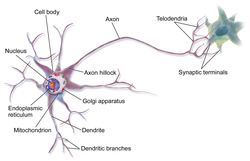 Anatomy of amultipolar neuron | |
| Identifiers | |
| MeSH | D009474 |
| NeuroLexID | sao1417703748 |
| TA98 | A14.0.00.002 |
| TH | H2.00.06.1.00002 |
| FMA | 54527 |
| Anatomical terms of neuroanatomy | |
Aneuron,neurone,ornerve cellis anexcitablecellthat fires electric signals calledaction potentialsacross aneural networkin thenervous system.Neurons communicate with other cells viasynapses,which are specialized connections that commonly use minute amounts of chemicalneurotransmittersto pass the electric signal from the presynaptic neuron to the target cell through the synaptic gap.
Neurons are the main components ofnervous tissuein allanimalsexceptspongesandplacozoans.Plantsandfungido not have nerve cells. Molecular evidence suggests that the ability to generate electric signals first appeared in evolution some 700 to 800 million years ago, during theTonianperiod. Predecessors of neurons were thepeptidergicsecretory cells. They eventually gained new gene modules which enabled cells to create post-synaptic scaffolds and ion channels that generate fast electrical signals. The ability to generate electric signals was a key innovation in the evolution of the nervous system.[1]
Neurons are typically classified into three types based on their function.Sensory neuronsrespond tostimulisuch as touch, sound, or light that affect the cells of thesensory organs,and they send signals to thespinal cordorbrain.Motor neuronsreceive signals from the brain and spinal cord to control everything frommuscle contractions[2]toglandular output.Interneuronsconnect neurons to other neurons within the same region of the brain or spinal cord. When multiple neurons are functionally connected together, they form what is called aneural circuit.
A neuron contains all the structures of other cells such as anucleus,mitochondria,andGolgi bodiesbut has additional unique structures such as anaxon,anddendrites.[3]The soma is a compact structure, and the axon and dendrites are filaments extruding from the soma. Dendrites typically branch profusely and extend a few hundred micrometers from the soma. The axon leaves the soma at a swelling called theaxon hillockand travels for as far as 1 meter in humans or more in other species. It branches but usually maintains a constant diameter. At the farthest tip of the axon's branches areaxon terminals,where the neuron can transmit a signal across thesynapseto another cell. Neurons may lack dendrites or have no axon. The termneuriteis used to describe either a dendrite or an axon, particularly when the cell isundifferentiated.
Most neurons receive signals via the dendrites and soma and send out signals down the axon. At the majority of synapses, signals cross from the axon of one neuron to a dendrite of another. However, synapses can connect an axon to another axon or a dendrite to another dendrite. The signaling process is partly electrical and partly chemical. Neurons are electrically excitable, due to maintenance ofvoltagegradients across theirmembranes.If the voltage changes by a large enough amount over a short interval, the neuron generates anall-or-nothingelectrochemicalpulse called anaction potential.This potential travels rapidly along the axon and activates synaptic connections as it reaches them. Synaptic signals may beexcitatoryorinhibitory,increasing or reducing the net voltage that reaches the soma.
In most cases, neurons are generated byneural stem cellsduring brain development and childhood.Neurogenesislargely ceases during adulthood in most areas of the brain.
Nervous system
[edit]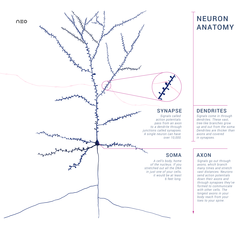
Neurons are the primary components of thenervous system,along with theglial cellsthat give them structural and metabolic support.[4]The nervous system is made up of thecentral nervous system,which includes thebrainandspinal cord,and theperipheral nervous system,which includes theautonomic,entericandsomatic nervous systems.[5]In vertebrates, the majority of neurons belong to thecentral nervous system,but some reside in peripheralganglia,and many sensory neurons are situated in sensory organs such as theretinaandcochlea.
Axons may bundle intonerve fasciclesthat make up thenervesin the peripheral nervous system (like strands of wire that make up a cable). In the central nervous system bundles of axons are callednerve tracts.
Anatomy and histology
[edit]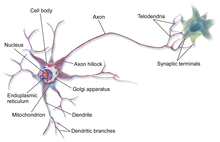
Neurons are highly specialized for the processing and transmission of cellular signals. Given their diversity of functions performed in different parts of the nervous system, there is a wide variety in their shape, size, and electrochemical properties. For instance, the soma of a neuron can vary from 4 to 100micrometersin diameter.[6]
- Thesomais the body of the neuron. As it contains thenucleus,mostprotein synthesisoccurs here. The nucleus can range from 3 to 18 micrometers in diameter.[7]
- Thedendritesof a neuron are cellular extensions with many branches. This overall shape and structure are referred to metaphorically as a dendritic tree. This is where the majority of input to the neuron occurs via thedendritic spine.
- Theaxonis a finer, cable-like projection that can extend tens, hundreds, or even tens of thousands of times the diameter of the soma in length. The axon primarily carriesnerve signalsaway from the soma and carries some types of information back to it. Many neurons have only one axon, but this axon may—and usually will—undergo extensive branching, enabling communication with many target cells. The part of the axon where it emerges from the soma is called theaxon hillock.Besides being an anatomical structure, the axon hillock also has the greatest density ofvoltage-dependent sodium channels.This makes it the most easily excited part of the neuron and the spike initiation zone for the axon. In electrophysiological terms, it has the most negativethreshold potential.
- While the axon and axon hillock are generally involved in information outflow, this region can also receive input from other neurons.
- Theaxon terminalis found at the end of the axon farthest from the soma and containssynapses.Synaptic boutons are specialized structures whereneurotransmitterchemicals are released to communicate with target neurons. In addition to synaptic boutons at the axon terminal, a neuron may haveen passantboutons, which are located along the length of the axon.
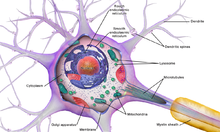
The accepted view of the neuron attributes dedicated functions to its various anatomical components; however, dendrites and axons often act in ways contrary to their so-called main function.[8]
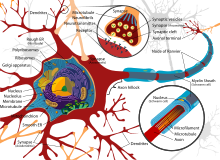
Axons and dendrites in the central nervous system are typically only about one micrometer thick, while some in the peripheral nervous system are much thicker. The soma is usually about 10–25 micrometers in diameter and often is not much larger than the cell nucleus it contains. The longest axon of a humanmotor neuroncan be over a meter long, reaching from the base of the spine to the toes.
Sensory neurons can have axons that run from the toes to theposterior columnof the spinal cord, over 1.5 meters in adults.Giraffeshave single axons several meters in length running along the entire length of their necks. Much of what is known about axonal function comes from studying thesquid giant axon,an ideal experimental preparation because of its relatively immense size (0.5–1 millimeter thick, several centimeters long).
Fully differentiated neurons are permanentlypostmitotic[9]however, stem cells present in the adult brain may regenerate functional neurons throughout the life of an organism (seeneurogenesis).Astrocytesare star-shapedglial cellsthat have been observed to turn into neurons by virtue of their stem cell-like characteristic ofpluripotency.[10]
Membrane
[edit]Like all animal cells, the cell body of every neuron is enclosed by aplasma membrane,a bilayer oflipidmolecules with many types of protein structures embedded in it.[11]A lipid bilayer is a powerful electricalinsulator,but in neurons, many of the protein structures embedded in the membrane are electrically active. These include ion channels that permit electrically charged ions to flow across the membrane and ion pumps that chemically transport ions from one side of the membrane to the other. Most ion channels are permeable only to specific types of ions. Some ion channels arevoltage gated,meaning that they can be switched between open and closed states by altering the voltage difference across the membrane. Others are chemically gated, meaning that they can be switched between open and closed states by interactions with chemicals that diffuse through the extracellular fluid. Theionmaterials includesodium,potassium,chloride,andcalcium.The interactions between ion channels and ion pumps produce a voltage difference across the membrane, typically a bit less than 1/10 of a volt at baseline. This voltage has two functions: first, it provides a power source for an assortment of voltage-dependent protein machinery that is embedded in the membrane; second, it provides a basis for electrical signal transmission between different parts of the membrane.
Histology and internal structure
[edit]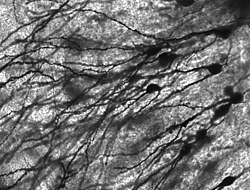

Numerous microscopic clumps calledNissl bodies(or Nissl substance) are seen when nerve cell bodies are stained with a basophilic ( "base-loving" ) dye. These structures consist ofrough endoplasmic reticulumand associatedribosomal RNA.Named after German psychiatrist and neuropathologistFranz Nissl(1860–1919), they are involved in protein synthesis and their prominence can be explained by the fact that nerve cells are very metabolically active. Basophilic dyes such asanilineor (weakly)haematoxylin[12]highlight negatively charged components, and so bind to the phosphate backbone of the ribosomal RNA.
The cell body of a neuron is supported by a complex mesh of structural proteins calledneurofilaments,which together with neurotubules (neuronal microtubules) are assembled into larger neurofibrils.[13]Some neurons also contain pigment granules, such asneuromelanin(a brownish-black pigment that is byproduct of synthesis ofcatecholamines), andlipofuscin(a yellowish-brown pigment), both of which accumulate with age.[14][15][16]Other structural proteins that are important for neuronal function areactinand thetubulinofmicrotubules.Class III β-tubulinis found almost exclusively in neurons. Actin is predominately found at the tips of axons and dendrites during neuronal development. There the actin dynamics can be modulated via an interplay with microtubule.[17]
There are different internal structural characteristics between axons and dendrites. Typical axons almost never containribosomes,except some in the initial segment. Dendrites contain granular endoplasmic reticulum or ribosomes, in diminishing amounts as the distance from the cell body increases.
Classification
[edit]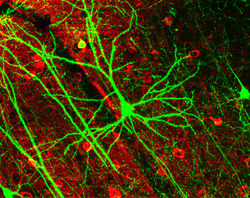
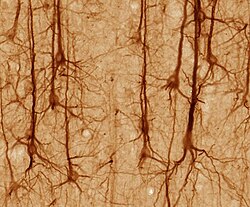
Neurons vary in shape and size and can be classified by theirmorphologyand function.[19]The anatomistCamillo Golgigrouped neurons into two types; type I with long axons used to move signals over long distances and type II with short axons, which can often be confused with dendrites. Type I cells can be further classified by the location of the soma. The basic morphology of type I neurons, represented by spinalmotor neurons,consists of a cell body called the soma and a long thin axon covered by amyelin sheath.The dendritic tree wraps around the cell body and receives signals from other neurons. The end of the axon has branchingaxon terminalsthat release neurotransmitters into a gap called thesynaptic cleftbetween the terminals and the dendrites of the next neuron.[citation needed]
Structural classification
[edit]Polarity
[edit]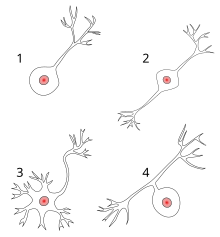
1Unipolar neuron
2Bipolar neuron
3Multipolar neuron
4Pseudounipolar neuron
Most neurons can be anatomically characterized as:[3]
- Unipolar:single process. Unipolar cells are exclusively sensory neurons. Their dendrites are receiving sensory information, sometimes directly from the stimulus itself. The cell bodies of unipolar neurons are always found in ganglia. Sensory reception is a peripheral function, so the cell body is in the periphery, though closer to the CNS in a ganglion. The axon projects from the dendrite endings, past the cell body in a ganglion, and into the central nervous system.
- Bipolar:1 axon and 1 dendrite. They are found mainly in theolfactory epithelium,and as part of the retina.
- Multipolar:1 axon and 2 or more dendrites
- Anaxonic:where the axon cannot be distinguished from the dendrite(s)
- Pseudounipolar:1 process which then serves as both an axon and a dendrite
Other
[edit]Some unique neuronal types can be identified according to their location in the nervous system and distinct shape. Some examples are:[citation needed]
- Basket cells,interneurons that form a dense plexus of terminals around the soma of target cells, found in the cortex andcerebellum
- Betz cells,large motor neurons
- Lugaro cells,interneurons of the cerebellum
- Medium spiny neurons,most neurons in thecorpus striatum
- Purkinje cells,huge neurons in the cerebellum, a type of Golgi I multipolar neuron
- Pyramidal cells,neurons with triangular soma, a type of Golgi I
- Rosehip cells,unique human inhibitory neurons that interconnect with Pyramidal cells
- Renshaw cells,neurons with both ends linked toAlpha motor neurons
- Unipolar brush cells,interneurons with unique dendrite ending in a brush-like tuft
- Granule cells,a type of Golgi II neuron
- Anterior horncells,motoneuronslocated in the spinal cord
- Spindle cells,interneurons that connect widely separated areas of the brain
Functional classification
[edit]Direction
[edit]- Afferent neuronsconvey information from tissues and organs into the central nervous system and are also calledsensory neurons.
- Efferent neurons(motor neurons) transmit signals from the central nervous system to the effector cells.
- Interneuronsconnect neurons within specific regions of the central nervous system.
Afferent and efferent also refer generally to neurons that, respectively, bring information to or send information from the brain.
Action on other neurons
[edit]A neuron affects other neurons by releasing a neurotransmitter that binds tochemical receptors.The effect upon the postsynaptic neuron is determined by the type of receptor that is activated, not by the presynaptic neuron or by the neurotransmitter. A neurotransmitter can be thought of as a key, and a receptor as a lock: the same neurotransmitter can activate multiple types of receptors. Receptors can be classified broadly asexcitatory(causing an increase in firing rate),inhibitory(causing a decrease in firing rate), ormodulatory(causing long-lasting effects not directly related to firing rate).[citation needed]
The two most common (90%+) neurotransmitters in the brain,glutamateandGABA,have largely consistent actions. Glutamate acts on several types of receptors, and has effects that are excitatory ationotropic receptorsand a modulatory effect atmetabotropic receptors.Similarly, GABA acts on several types of receptors, but all of them have inhibitory effects (in adult animals, at least). Because of this consistency, it is common for neuroscientists to refer to cells that release glutamate as "excitatory neurons", and cells that release GABA as "inhibitory neurons". Some other types of neurons have consistent effects, for example, "excitatory" motor neurons in the spinal cord that releaseacetylcholine,and "inhibitory"spinal neuronsthat releaseglycine.[citation needed]
The distinction between excitatory and inhibitory neurotransmitters is not absolute. Rather, it depends on the class of chemical receptors present on the postsynaptic neuron. In principle, a single neuron, releasing a single neurotransmitter, can have excitatory effects on some targets, inhibitory effects on others, and modulatory effects on others still. For example,photoreceptor cellsin the retina constantly release the neurotransmitter glutamate in the absence of light. So-called OFFbipolar cellsare, like most neurons, excited by the released glutamate. However, neighboring target neurons called ON bipolar cells are instead inhibited by glutamate, because they lack typicalionotropicglutamate receptorsand instead express a class of inhibitorymetabotropicglutamate receptors.[20]When light is present, the photoreceptors cease releasing glutamate, which relieves the ON bipolar cells from inhibition, activating them; this simultaneously removes the excitation from the OFF bipolar cells, silencing them.[citation needed]
It is possible to identify the type of inhibitory effect a presynaptic neuron will have on a postsynaptic neuron, based on the proteins the presynaptic neuron expresses.Parvalbumin-expressing neurons typically dampen the output signal of the postsynaptic neuron in thevisual cortex,whereassomatostatin-expressing neurons typically block dendritic inputs to the postsynaptic neuron.[21]
Discharge patterns
[edit]Neurons have intrinsic electroresponsive properties like intrinsic transmembrane voltageoscillatorypatterns.[22]So neurons can be classified according to theirelectrophysiologicalcharacteristics:
- Tonic or regular spiking. Some neurons are typically constantly (tonically) active, typically firing at a constant frequency. Example: interneurons inneurostriatum.
- Phasic orbursting.Neurons that fire in bursts are called phasic.
- Fast-spiking. Some neurons are notable for their high firing rates, for example some types of cortical inhibitory interneurons, cells inglobus pallidus,retinal ganglion cells.[23][24]
Neurotransmitter
[edit]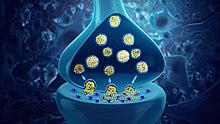
Neurotransmittersare chemical messengers passed from one neuron to another neuron or to amuscle cellorgland cell.
- Cholinergic neurons – acetylcholine.Acetylcholineis released from presynaptic neurons into the synaptic cleft. It acts as aligandfor both ligand-gated ion channels andmetabotropic(GPCRs)muscarinic receptors.Nicotinic receptorsare pentameric ligand-gated ion channels composed of Alpha and beta subunits that bindnicotine.Ligand binding opens the channel causing influx ofNa+depolarization and increases the probability of presynaptic neurotransmitter release. Acetylcholine is synthesized fromcholineandacetyl coenzyme A.
- Adrenergic neurons – noradrenaline.Noradrenaline(norepinephrine) is released from mostpostganglionicneurons in thesympathetic nervous systemonto two sets of GPCRs:Alpha adrenoceptorsandbeta adrenoceptors.Noradrenaline is one of the three commoncatecholamineneurotransmitter, and the most prevalent of them in theperipheral nervous system;as with other catecholamines, it is synthesised fromtyrosine.
- GABAergic neurons –gamma aminobutyric acid.GABA is one of two neuroinhibitors in thecentral nervous system(CNS), along with glycine. GABA has a homologous function toACh,gating anion channels that allowCl−ions to enter the post synaptic neuron. Cl−causes hyperpolarization within the neuron, decreasing the probability of an action potential firing as the voltage becomes more negative (for an action potential to fire, a positive voltage threshold must be reached). GABA is synthesized from glutamate neurotransmitters by the enzymeglutamate decarboxylase.
- Glutamatergic neurons – glutamate.Glutamateis one of two primary excitatory amino acid neurotransmitters, along withaspartate.Glutamate receptors are one of four categories, three of which are ligand-gated ion channels and one of which is aG-proteincoupled receptor (often referred to as GPCR).
- AMPAandKainatereceptors function ascationchannels permeable to Na+cation channels mediating fast excitatory synaptic transmission.
- NMDAreceptors are another cation channel that is more permeable toCa2+.The function of NMDA receptors depend on glycine receptor binding as a co-agonistwithin the channel pore. NMDA receptors do not function without both ligands present.
- Metabotropic receptors, GPCRs modulate synaptic transmission and postsynaptic excitability.
- Glutamate can cause excitotoxicity when blood flow to the brain is interrupted, resulting inbrain damage.When blood flow is suppressed, glutamate is released from presynaptic neurons, causing greater NMDA and AMPA receptor activation than normal outside of stress conditions, leading to elevated Ca2+and Na+entering the post synaptic neuron and cell damage. Glutamate is synthesized from the amino acid glutamine by the enzymeglutamate synthase.
- Dopaminergic neurons—dopamine.Dopamineis a neurotransmitter that acts on D1 type (D1 and D5) Gs-coupled receptors, which increase cAMP and PKA, and D2 type (D2, D3, and D4) receptors, which activate Gi-coupled receptors that decrease cAMP and PKA. Dopamine is connected to mood and behavior and modulates both pre- and post-synaptic neurotransmission. Loss of dopamine neurons in thesubstantia nigrahas been linked toParkinson's disease.Dopamine is synthesized from the amino acidtyrosine.Tyrosine is catalyzed into levodopa (orL-DOPA) bytyrosine hydroxlase,and levodopa is then converted into dopamine by the aromatic amino aciddecarboxylase.
- Serotonergic neurons—serotonin.Serotonin(5-Hydroxytryptamine, 5-HT) can act as excitatory or inhibitory. Of its four 5-HT receptor classes, 3 are GPCR and 1 is a ligand-gated cation channel. Serotonin is synthesized fromtryptophanbytryptophan hydroxylase,and then further by decarboxylase. A lack of 5-HT at postsynaptic neurons has been linked to depression. Drugs that block the presynapticserotonin transporterare used for treatment, such asProzacandZoloft.
- Purinergic neurons—ATP.ATPis a neurotransmitter acting at both ligand-gated ion channels (P2Xreceptors) and GPCRs (P2Y) receptors. ATP is, however, best known as acotransmitter.Suchpurinergic signallingcan also be mediated by otherpurineslikeadenosine,which particularly acts at P2Y receptors.
- Histaminergic neurons—histamine.Histamineis amonoamine neurotransmitterandneuromodulator.Histamine-producing neurons are found in thetuberomammillary nucleusof thehypothalamus.[25]Histamine is involved inarousaland regulating sleep/wake behaviors.
Multimodel classification
[edit]Since 2012 there has been a push from the cellular andcomputational neurosciencecommunity to come up with a universal classification of neurons that will apply to all neurons in the brain as well as across species. This is done by considering the three essential qualities of all neurons: electrophysiology, morphology, and the individual transcriptome of the cells. Besides being universal this classification has the advantage of being able to classify astrocytes as well. A method calledpatch-sequencingin which all three qualities can be measured at once is used extensively by theAllen Institute for Brain Science.[26]In 2023, a comprehensive cell atlas of the adult, and developing human brain at the transcriptional, epigenetic, and functional levels was created through an international collaboration of researchers using the most cutting-edge molecular biology approaches.[27]
Connectivity
[edit]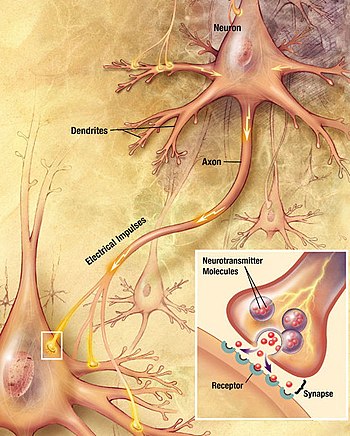
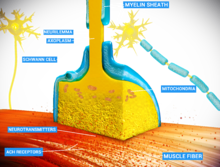
Neurons communicate with each other viasynapses,where either theaxon terminalof one cell contacts another neuron's dendrite, soma or, less commonly, axon. Neurons such as Purkinje cells in the cerebellum can have over 1000 dendritic branches, making connections with tens of thousands of other cells; other neurons, such as the magnocellular neurons of thesupraoptic nucleus,have only one or two dendrites, each of which receives thousands of synapses.
Synapses can be excitatory or inhibitory, either increasing or decreasing activity in the target neuron, respectively. Some neurons also communicate via electrical synapses, which are direct, electrically conductivejunctionsbetween cells.[28]
When an action potential reaches the axon terminal, it opensvoltage-gated calcium channels,allowingcalcium ionsto enter the terminal. Calcium causessynaptic vesiclesfilled with neurotransmitter molecules to fuse with the membrane, releasing their contents into the synaptic cleft. The neurotransmitters diffuse across the synaptic cleft and activate receptors on the postsynaptic neuron. High cytosolic calcium in theaxon terminaltriggers mitochondrial calcium uptake, which, in turn, activates mitochondrialenergy metabolismto produceATPto support continuous neurotransmission.[29]
Anautapseis a synapse in which a neuron's axon connects to its own dendrites.
Thehuman brainhas some 8.6 x 1010(eighty six billion) neurons.[30][31]Each neuron has on average 7,000 synaptic connections to other neurons. It has been estimated that the brain of a three-year-old child has about 1015synapses (1 quadrillion).This number declines with age,stabilizing by adulthood. Estimates vary for an adult, ranging from 1014to 5 x 1014synapses (100 to 500 trillion).[32]

Nonelectrochemical signaling
[edit]Beyond electrical and chemical signaling, studies suggest neurons in healthy human brains can also communicate through:
- force generated by the enlargement of dendritic spines[33]
- the transfer ofproteins– transneuronally transported proteins (TNTPs)[34][35]
They can also get modulated by input from the environment andhormonesreleased from other parts of the organism,[36]which could be influenced more or less directly by neurons. This also applies toneurotrophinssuch asBDNF.Thegut microbiomeis also connected with the brain.[37] Neurons also communicate withmicroglia,the brain's main immune cells via specialised contact sites, called "somatic junctions". These connections enable microglia to constantly monitor and regulate neuronal functions, and exert neuroprotection, when needed.[38]
Mechanisms for propagating action potentials
[edit]In 1937John Zachary Youngsuggested that thesquid giant axoncould be used to study neuronal electrical properties.[39]It is larger than but similar to human neurons, making it easier to study. By inserting electrodes into the squid giant axons, accurate measurements were made of themembrane potential.
The cell membrane of the axon and soma contain voltage-gated ion channels that allow the neuron to generate and propagate an electrical signal (an action potential). Some neurons also generatesubthreshold membrane potential oscillations.These signals are generated and propagated by charge-carryingionsincluding sodium (Na+), potassium (K+), chloride (Cl−), andcalcium (Ca2+).
Several stimuli can activate a neuron leading to electrical activity, includingpressure,stretch, chemical transmitters, and changes of the electric potential across the cell membrane.[40]Stimuli cause specific ion-channels within the cell membrane to open, leading to a flow of ions through the cell membrane, changing the membrane potential. Neurons must maintain the specific electrical properties that define their neuron type.[41]
Thin neurons and axons require lessmetabolicexpense to produce and carry action potentials, but thicker axons convey impulses more rapidly. To minimize metabolic expense while maintaining rapid conduction, many neurons have insulating sheaths ofmyelinaround their axons. The sheaths are formed byglialcells:oligodendrocytesin the central nervous system andSchwann cellsin the peripheral nervous system. The sheath enables action potentials to travelfasterthan in unmyelinated axons of the same diameter, whilst using less energy. The myelin sheath in peripheral nerves normally runs along the axon in sections about 1 mm long, punctuated by unsheathednodes of Ranvier,which contain a high density of voltage-gated ion channels.Multiple sclerosisis a neurological disorder that results from demyelination of axons in the central nervous system.
Some neurons do not generate action potentials, but instead generate agraded electrical signal,which in turn causes graded neurotransmitter release. Suchnon-spiking neuronstend to be sensory neurons or interneurons, because they cannot carry signals long distances.
Neural coding
[edit]Neural codingis concerned with how sensory and other information is represented in the brain by neurons. The main goal of studying neural coding is to characterize the relationship between thestimulusand the individual orensembleneuronal responses and the relationships among the electrical activities of the neurons within the ensemble.[42]It is thought that neurons can encode bothdigitalandanaloginformation.[43]
All-or-none principle
[edit]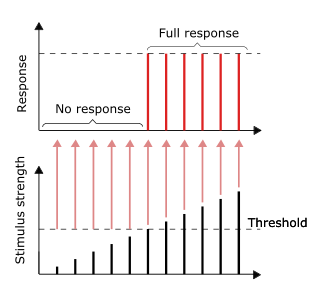
The conduction of nerve impulses is an example of anall-or-noneresponse. In other words, if a neuron responds at all, then it must respond completely. Greater intensity of stimulation, like brighter image/louder sound, does not produce a stronger signal but can increase firing frequency.[44]: 31 Receptors respond in different ways to stimuli. Slowly adapting ortonic receptorsrespond to a steady stimulus and produce a steady rate of firing. Tonic receptors most often respond to increased stimulus intensity by increasing their firing frequency, usually as a power function of stimulus plotted against impulses per second. This can be likened to an intrinsic property of light where greater intensity of a specific frequency (color) requires more photons, as the photons can not become "stronger" for a specific frequency.
Other receptor types include quickly adapting or phasic receptors, where firing decreases or stops with a steady stimulus; examples includeskinwhich, when touched causes neurons to fire, but if the object maintains even pressure, the neurons stop firing. The neurons of the skin and muscles that are responsive to pressure and vibration have filtering accessory structures that aid their function.
Thepacinian corpuscleis one such structure. It has concentric layers like an onion, which form around the axon terminal. When pressure is applied and the corpuscle is deformed, mechanical stimulus is transferred to the axon, which fires. If the pressure is steady, the stimulus ends; thus, these neurons typically respond with a transient depolarization during the initial deformation and again when the pressure is removed, which causes the corpuscle to change shape again. Other types of adaptation are important in extending the function of a number of other neurons.[45]
Etymology and spelling
[edit]The German anatomistHeinrich Wilhelm Waldeyerintroduced the termneuronin 1891,[46]based on theancient Greekνεῦρονneuron'sinew, cord, nerve'.[47]
The word was adopted in French with the spellingneurone.That spelling was also used by many writers in English,[48]but has now become rare in American usage and uncommon in British usage.[49][47]
History
[edit]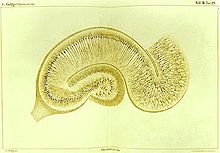
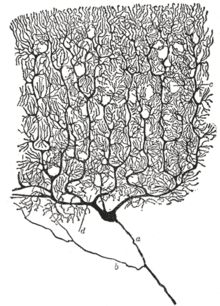
The neuron's place as the primary functional unit of the nervous system was first recognized in the late 19th century through the work of the Spanish anatomistSantiago Ramón y Cajal.[50]
To make the structure of individual neurons visible, Ramón y Cajal improved asilver staining processthat had been developed byCamillo Golgi.[50]The improved process involves a technique called "double impregnation" and is still in use.
In 1888 Ramón y Cajal published a paper about the bird cerebellum. In this paper, he stated that he could not find evidence foranastomosisbetween axons and dendrites and called each nervous element "an absolutely autonomous canton."[50][46]This became known as theneuron doctrine,one of the central tenets of modernneuroscience.[50]
In 1891, the German anatomistHeinrich Wilhelm Waldeyerwrote a highly influential review of the neuron doctrine in which he introduced the termneuronto describe the anatomical and physiological unit of the nervous system.[51][52]
The silver impregnation stains are a useful method forneuroanatomicalinvestigations because, for reasons unknown, it stains only a small percentage of cells in a tissue, exposing the complete micro structure of individual neurons without much overlap from other cells.[53]
Neuron doctrine
[edit]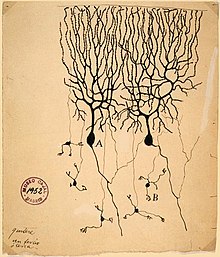
The neuron doctrine is the now fundamental idea that neurons are the basic structural and functional units of the nervous system. The theory was put forward by Santiago Ramón y Cajal in the late 19th century. It held that neurons are discrete cells (not connected in a meshwork), acting as metabolically distinct units.
Later discoveries yielded refinements to the doctrine. For example,glial cells,which are non-neuronal, play an essential role in information processing.[54]Also, electrical synapses are more common than previously thought,[55]comprising direct, cytoplasmic connections between neurons. In fact, neurons can form even tighter couplings: the squid giant axon arises from the fusion of multiple axons.[56]
Ramón y Cajal also postulated the Law of Dynamic Polarization, which states that a neuron receives signals at its dendrites and cell body and transmits them, as action potentials, along the axon in one direction: away from the cell body.[57]The Law of Dynamic Polarization has important exceptions; dendrites can serve as synaptic output sites of neurons[58]and axons can receive synaptic inputs.[59]
Compartmental modelling of neurons
[edit]Although neurons are often described of as "fundamental units" of the brain, they perform internal computations. Neurons integrate input within dendrites, and this complexity is lost in models that assume neurons to be a fundamental unit. Dendritic branches can be modeled as spatial compartments, whose activity is related due to passive membrane properties, but may also be different depending on input from synapses.Compartmental modelling of dendritesis especially helpful for understanding the behavior of neurons that are too small to record with electrodes, as is the case forDrosophila melanogaster.[60]
Neurons in the brain
[edit]The number of neurons in the brain varies dramatically from species to species.[61]In a human, there are an estimated 10–20 billion neurons in thecerebral cortexand 55–70 billion neurons in thecerebellum.[62]By contrast, thenematodewormCaenorhabditis eleganshas just 302 neurons, making it an idealmodel organismas scientists have been able to map all of its neurons. The fruit flyDrosophila melanogaster,a common subject in biological experiments, has around 100,000 neurons and exhibits many complex behaviors. Many properties of neurons, from the type of neurotransmitters used to ion channel composition, are maintained across species, allowing scientists to study processes occurring in more complex organisms in much simpler experimental systems.
Neurological disorders
[edit]This articleneeds additional citations forverification.(May 2018) |
Charcot–Marie–Tooth disease(CMT) is a heterogeneous inherited disorder of nerves (neuropathy) that is characterized by loss of muscle tissue and touch sensation, predominantly in the feet and legs extending to the hands and arms in advanced stages. Presently incurable, this disease is one of the most common inheritedneurological disorders,affecting 36 in 100,000 people.[63]
Alzheimer's disease(AD), also known simply asAlzheimer's,is aneurodegenerative diseasecharacterized by progressivecognitivedeterioration, together with declining activities of daily living andneuropsychiatricsymptoms or behavioral changes.[64]The most striking early symptom is loss of short-term memory (amnesia), which usually manifests as minor forgetfulness that becomes steadily more pronounced with illness progression, with relative preservation of older memories. As the disorder progresses, cognitive (intellectual) impairment extends to the domains of language (aphasia), skilled movements (apraxia), and recognition (agnosia), and functions such as decision-making and planning become impaired.[65][66]
Parkinson's disease(PD), also known asParkinsons,is a degenerative disorder of the central nervous system that often impairs motor skills and speech.[67]Parkinson's disease belongs to a group of conditions calledmovement disorders.[68]It is characterized by muscle rigidity,tremor,a slowing of physical movement (bradykinesia), and in extreme cases, a loss of physical movement (akinesia). The primary symptoms are the results of decreased stimulation of themotor cortexby thebasal ganglia,normally caused by the insufficient formation and action of dopamine, which is produced in thedopaminergic neuronsof the brain. Secondary symptoms may include high levelcognitive dysfunctionand subtle language problems. PD is both chronic and progressive.
Myasthenia gravisis aneuromuscular diseaseleading to fluctuatingmuscle weaknessand fatigability during simple activities. Weakness is typically caused by circulatingantibodiesthat blockacetylcholine receptorsat the postsynaptic neuromuscular junction, inhibiting the stimulative effect of the neurotransmitter acetylcholine. Myasthenia is treated withimmunosuppressants,cholinesteraseinhibitors and, in selected cases,thymectomy.
Demyelination
[edit]
Demyelinationis a process characterized by the gradual loss of the myelin sheath enveloping nerve fibers. When myelin deteriorates, signal conduction along nerves can be significantly impaired or lost, and the nerve eventually withers. Demyelination may affect both central and peripheral nervous systems, contributing to various neurological disorders such asmultiple sclerosis,Guillain-Barré syndrome,andchronic inflammatory demyelinating polyneuropathy.Although demyelination is often caused by anautoimmunereaction, it may also be caused by viral infections, metabolic disorders, trauma, and some medications.
Axonal degeneration
[edit]Although most injury responses include a calcium influx signaling to promote resealing of severed parts, axonal injuries initially lead to acuteaxonal degeneration,which is the rapid separation of the proximal and distal ends, occurring within 30 minutes of injury.[69]Degeneration follows with swelling of theaxolemma,and eventually leads to bead-like formation. Granular disintegration of the axonalcytoskeletonand innerorganellesoccurs after axolemma degradation. Early changes include accumulation ofmitochondriain the paranodal regions at the site of injury. Endoplasmic reticulum degrades and mitochondria swell up and eventually disintegrate. The disintegration is dependent onubiquitinandcalpainproteases(caused by the influx of calcium ion), suggesting that axonal degeneration is an active process that produces complete fragmentation. The process takes about roughly 24 hours in the PNS and longer in the CNS. The signaling pathways leading to axolemma degeneration are unknown.
Development
[edit]Neurons develop through the process ofneurogenesis,in whichneural stem cellsdivide to producedifferentiated neurons.Once fully differentiated they are no longer capable of undergoingmitosis.Neurogenesis primarily occurs duringembryonic development.
Neurons initially develop from theneural tubein the embryo. The neural tube has three layers – aventricular zone,anintermediate zone,and a marginal zone. The ventricular zone surrounds the tube's central canal, and becomes theependyma.Dividing cells of the ventricular zone form the intermediate zone which stretches to the outermost layer of the neural tube called the pial layer. Thegray matterof the brain is derived from the intermediate zone. The extensions of the neurons in the intermediate zone make up the marginal zone that whenmyelinatedbecome the brain'swhite matter.[70]
Differentiation of the neurons is ordered by their size. Largemotor neuronsare first. Smaller sensory neurons together withglial cellsdifferentiate atbirth.[70]
Adult neurogenesiscan occur and studies of the age of human neurons suggest that this process occurs only for a minority of cells, and that the vast majority of neurons in theneocortexforms before birth and persists without replacement. The extent to which adult neurogenesis exists in humans, and its contribution to cognition are controversial, with conflicting reports published in 2018.[71]
The body contains a variety of stem cell types that have the capacity to differentiate into neurons. Researchers found a way to transform human skin cells into nerve cells usingtransdifferentiation,in which "cells are forced to adopt new identities".[72]
Duringneurogenesisin the mammalian brain, progenitor and stem cells progress from proliferative divisions to differentiative divisions. This progression leads to the neurons and glia that populate cortical layers.Epigeneticmodifications play a key role in regulatinggene expressionin differentiatingneural stem cells,and are critical for cell fate determination in the developing and adult mammalian brain. Epigenetic modifications includeDNA cytosine methylationto form5-methylcytosineand5-methylcytosine demethylation.[73]These modifications are critical for cell fate determination in the developing and adult mammalian brain.DNA cytosine methylationis catalyzed byDNA methyltransferases (DNMTs).Methylcytosine demethylation is catalyzed in several stages byTET enzymesthat carry out oxidative reactions (e.g.5-methylcytosineto5-hydroxymethylcytosine) and enzymes of the DNAbase excision repair(BER) pathway.[73]
At different stages of mammalian nervous system development two DNA repair processes are employed in the repair of DNA double-strand breaks. These pathways arehomologous recombinationalrepair used in proliferating neural precursor cells, andnon-homologous end joiningused mainly at later developmental stages[74]
Intercellular communication between developing neurons andmicrogliais also indispensable for proper neurogenesis and brain development.[75]
Nerve regeneration
[edit]Peripheral axons can regrow if they are severed,[76]but one neuron cannot be functionally replaced by one of another type (Llinás' law).[22]
See also
[edit]References
[edit]- ^Najle, Sebastián R.; Grau-Bové, Xavier; Elek, Anamaria; Navarrete, Cristina; Cianferoni, Damiano; Chiva, Cristina; Cañas-Armenteros, Didac; Mallabiabarrena, Arrate; Kamm, Kai; Sabidó, Eduard; Gruber-Vodicka, Harald; Schierwater, Bernd; Serrano, Luis; Sebé-Pedrós, Arnau (Oct 2023)."Stepwise emergence of the neuronal gene expression program in early animal evolution".Cell.186(21): 4676–4693.e29.doi:10.1016/j.cell.2023.08.027.PMC10580291.PMID37729907.
- ^Zayia LC, Tadi P.Neuroanatomy, Motor Neuron.[Updated 2022 Jul 25]. In: StatPearls [Internet]. Treasure Island (FL): StatPearls Publishing; 2023 Jan-.
- ^ab
 This article incorporatestextavailable under theCC BY 4.0license.Betts, J Gordon; Desaix, Peter; Johnson, Eddie; Johnson, Jody E; Korol, Oksana; Kruse, Dean; Poe, Brandon; Wise, James; Womble, Mark D; Young, Kelly A (June 8, 2023).Anatomy & Physiology.Houston: OpenStax CNX. 12.2 Nervous tissue.ISBN978-1-947172-04-3.
This article incorporatestextavailable under theCC BY 4.0license.Betts, J Gordon; Desaix, Peter; Johnson, Eddie; Johnson, Jody E; Korol, Oksana; Kruse, Dean; Poe, Brandon; Wise, James; Womble, Mark D; Young, Kelly A (June 8, 2023).Anatomy & Physiology.Houston: OpenStax CNX. 12.2 Nervous tissue.ISBN978-1-947172-04-3.
- ^Moore, Keith; Dalley, Arthur (2005).Clinically Oriented Anatomy(5th ed.). LWW. pp.47.ISBN0-7817-3639-0.
A bundle of nerve fibers (axons) connecting neighboring or distant nuclei of the CNS is a tract.
- ^"What are the parts of the nervous system?".October 2018.Retrieved2022-07-08.
- ^Davies, Melissa (2002-04-09)."The Neuron: size comparison".Neuroscience: A journey through the brain.Retrieved2009-06-20.
- ^Chudler EH."Brain Facts and Figures".Neuroscience for Kids.Retrieved2009-06-20.
- ^"16.7: Nervous System".Biology LibreTexts.2021-01-14.Retrieved2022-02-28.
- ^Herrup K, Yang Y (May 2007). "Cell cycle regulation in the postmitotic neuron: oxymoron or new biology?".Nature Reviews. Neuroscience.8(5): 368–78.doi:10.1038/nrn2124.PMID17453017.S2CID12908713.
- ^Talifu Z, Liu JY, Pan YZ, Ke H, Zhang CJ, Xu X, Gao F, Yu Y, Du LJ, Li JJ (April 2023)."In vivo astrocyte-to-neuron reprogramming for central nervous system regeneration: a narrative review".Neural Regen Res.18(4): 750–755.doi:10.4103/1673-5374.353482.PMC9700087.PMID36204831.
- ^Giménez, C. (February 1998)."[Composition and structure of the neuronal membrane: molecular basis of its physiology and pathology]".Revista de Neurologia.26(150): 232–239.ISSN0210-0010.PMID9563093.
- ^State Hospitals Bulletin.State Commission in Lunacy. 1897. p. 378.
- ^"Medical Definition of Neurotubules".merriam-webster.
- ^Zecca L, Gallorini M, Schünemann V, Trautwein AX, Gerlach M, Riederer P, Vezzoni P, Tampellini D (March 2001). "Iron, neuromelanin and ferritin content in the substantia nigra of normal subjects at different ages: consequences for iron storage and neurodegenerative processes".Journal of Neurochemistry.76(6): 1766–73.doi:10.1046/j.1471-4159.2001.00186.x.PMID11259494.S2CID31301135.
- ^Herrero MT, Hirsch EC, Kastner A, Luquin MR, Javoy-Agid F, Gonzalo LM, Obeso JA, Agid Y (1993). "Neuromelanin accumulation with age in catecholaminergic neurons from Macaca fascicularis brainstem".Developmental Neuroscience.15(1): 37–48.doi:10.1159/000111315.PMID7505739.
- ^Brunk UT, Terman A (September 2002). "Lipofuscin: mechanisms of age-related accumulation and influence on cell function".Free Radical Biology & Medicine.33(5): 611–9.doi:10.1016/s0891-5849(02)00959-0.PMID12208347.
- ^Zhao B, Meka DP, Scharrenberg R, König T, Schwanke B, Kobler O, Windhorst S, Kreutz MR, Mikhaylova M, Calderon de Anda F (August 2017)."Microtubules Modulate F-actin Dynamics during Neuronal Polarization".Scientific Reports.7(1): 9583.Bibcode:2017NatSR...7.9583Z.doi:10.1038/s41598-017-09832-8.PMC5575062.PMID28851982.
- ^Lee WC, Huang H, Feng G, Sanes JR, Brown EN, So PT, Nedivi E (February 2006)."Dynamic remodeling of dendritic arbors in GABAergic interneurons of adult visual cortex".PLOS Biology.4(2): e29.doi:10.1371/journal.pbio.0040029.PMC1318477.PMID16366735.
- ^Al, Martini, Frederic Et (2005).Anatomy and Physiology' 2007 Ed.2007 Edition.Rex Bookstore, Inc. p. 288.ISBN978-971-23-4807-5.
{{cite book}}:CS1 maint: multiple names: authors list (link) - ^Gerber U (January 2003). "Metabotropic glutamate receptors in vertebrate retina".Documenta Ophthalmologica. Advances in Ophthalmology.106(1): 83–7.doi:10.1023/A:1022477203420.PMID12675489.S2CID22296630.
- ^Wilson NR, Runyan CA, Wang FL, Sur M (August 2012)."Division and subtraction by distinct cortical inhibitory networks in vivo".Nature.488(7411): 343–8.Bibcode:2012Natur.488..343W.doi:10.1038/nature11347.hdl:1721.1/92709.PMC3653570.PMID22878717.
- ^abLlinás RR (2014-01-01)."Intrinsic electrical properties of mammalian neurons and CNS function: a historical perspective".Frontiers in Cellular Neuroscience.8:320.doi:10.3389/fncel.2014.00320.PMC4219458.PMID25408634.
- ^Kolodin YO, Veselovskaia NN, Veselovsky NS, Fedulova SA.Ion conductances related to shaping the repetitive firing in rat retinal ganglion cells.Acta Physiologica Congress. Archived fromthe originalon 2012-10-07.Retrieved2009-06-20.
- ^"Ionic conductances underlying excitability in tonically firing retinal ganglion cells of adult rat".Ykolodin.50webs. 2008-04-27.Retrieved2013-02-16.
- ^Scammell TE, Jackson AC, Franks NP, Wisden W, Dauvilliers Y (January 2019)."Histamine: neural circuits and new medications".Sleep.42(1).doi:10.1093/sleep/zsy183.PMC6335869.PMID30239935.
- ^"Patch-seq technique helps depict the variation of neural cells in the brain".News-medical.net.3 December 2020.Retrieved26 August2021.
- ^Science AAAS."BRAIN CELL CENSUS".Retrieved2023-10-17.
- ^Macpherson, Gordon (2002).Black's Medical Dictionary(40 ed.). Lanham, MD: Scarecrow Press. pp. 431–434.ISBN0810849844.
- ^Ivannikov MV, Macleod GT (June 2013)."Mitochondrial free Ca²⁺ levels and their effects on energy metabolism in Drosophila motor nerve terminals".Biophysical Journal.104(11): 2353–61.Bibcode:2013BpJ...104.2353I.doi:10.1016/j.bpj.2013.03.064.PMC3672877.PMID23746507.
- ^Herculano-Houzel S (November 2009)."The human brain in numbers: a linearly scaled-up primate brain".Frontiers in Human Neuroscience.3:31.doi:10.3389/neuro.09.031.2009.PMC2776484.PMID19915731.
- ^"Why is the human brain so difficult to understand? We asked 4 neuroscientists".Allen Institute.Retrieved17 October2023.
- ^Drachman DA (June 2005). "Do we have brain to spare?".Neurology.64(12): 2004–5.doi:10.1212/01.WNL.0000166914.38327.BB.PMID15985565.S2CID38482114.
- ^Ucar, Hasan; Watanabe, Satoshi; Noguchi, Jun; Morimoto, Yuichi; Iino, Yusuke; Yagishita, Sho; Takahashi, Noriko; Kasai, Haruo (December 2021). "Mechanical actions of dendritic-spine enlargement on presynaptic exocytosis".Nature.600(7890): 686–689.Bibcode:2021Natur.600..686U.doi:10.1038/s41586-021-04125-7.ISSN1476-4687.PMID34819666.S2CID244648506.
Lay summary:
"Forceful synapses reveal mechanical interactions in the brain".Nature.24 November 2021.doi:10.1038/d41586-021-03516-0.Retrieved21 February2022. - ^"Researchers discover new type of cellular communication in the brain".The Scripps Research Institute.Retrieved12 February2022.
- ^Schiapparelli, Lucio M.; Sharma, Pranav; He, Hai-Yan; Li, Jianli; Shah, Sahil H.; McClatchy, Daniel B.; Ma, Yuanhui; Liu, Han-Hsuan; Goldberg, Jeffrey L.; Yates, John R.; Cline, Hollis T. (25 January 2022)."Proteomic screen reveals diverse protein transport between connected neurons in the visual system".Cell Reports.38(4): 110287.doi:10.1016/j.celrep.2021.110287.ISSN2211-1247.PMC8906846.PMID35081342.
- ^Levitan, Irwin B.; Kaczmarek, Leonard K. (2015). "Electrical Signaling in Neurons".The Neuron.Oxford University Press. pp. 41–62.doi:10.1093/med/9780199773893.003.0003.ISBN978-0-19-977389-3.
- ^O’Leary, Olivia F.; Ogbonnaya, Ebere S.; Felice, Daniela; Levone, Brunno R.; C. Conroy, Lorraine; Fitzgerald, Patrick; Bravo, Javier A.; Forsythe, Paul; Bienenstock, John; Dinan, Timothy G.; Cryan, John F. (1 February 2018)."The vagus nerve modulates BDNF expression and neurogenesis in the hippocampus".European Neuropsychopharmacology.28(2): 307–316.doi:10.1016/j.euroneuro.2017.12.004.ISSN0924-977X.PMID29426666.S2CID46819013.
- ^Cserép C, Pósfai B, Lénárt N, Fekete R, László ZI, Lele Z (January 2020)."Microglia monitor and protect neuronal function through specialized somatic purinergic junctions".Science.367(6477): 528–537.Bibcode:2020Sci...367..528C.doi:10.1126/science.aax6752.PMID31831638.S2CID209343260.
- ^Chudler EH."Milestones in Neuroscience Research".Neuroscience for Kids.Retrieved2009-06-20.
- ^Patlak J, Gibbons R (2000-11-01)."Electrical Activity of Nerves".Action Potentials in Nerve Cells.Archived fromthe originalon August 27, 2009.Retrieved2009-06-20.
- ^Harris-Warrick, RM (October 2011)."Neuromodulation and flexibility in Central Pattern Generator networks".Current Opinion in Neurobiology.21(5): 685–92.doi:10.1016/j.conb.2011.05.011.PMC3171584.PMID21646013.
- ^Brown EN, Kass RE, Mitra PP (May 2004). "Multiple neural spike train data analysis: state-of-the-art and future challenges".Nature Neuroscience.7(5): 456–61.doi:10.1038/nn1228.PMID15114358.S2CID562815.
- ^Thorpe SJ (1990)."Spike arrival times: A highly efficient coding scheme for neural networks"(PDF).In Eckmiller R, Hartmann G, Hauske G (eds.).Parallel processing in neural systems and computers.North-Holland. pp. 91–94.ISBN9780444883902.Archived fromthe original(PDF)on 2012-02-15.
- ^abKalat, James W (2016).Biological psychology(12 ed.). Australia: Cengage Learning.ISBN9781305105409.OCLC898154491.
- ^Eckert R, Randall D (1983).Animal physiology: mechanisms and adaptations.San Francisco: W.H. Freeman. p.239.ISBN978-0-7167-1423-1.
- ^abFinger, Stanley (1994).Origins of neuroscience: a history of explorations into brain function.Oxford University Press. p. 47.ISBN9780195146943.OCLC27151391.
Ramon y Cajal's first paper on the Golgi stain was on the bird cerebellum, and it appeared in theRevistain 1888. He acknowledged that he found the nerve fibers to be very intricate, but stated that he could find no evidence for either axons or dendrites undergoing anastomosis and forming nets. He called each nervous element 'an absolutely autonomous canton.'
- ^abOxford English Dictionary,3rd edition, 2003,s.v.
- ^Mehta AR, Mehta PR, Anderson SP, MacKinnon BL, Compston A (January 2020)."Grey Matter Etymology and the neuron(e)".Brain.143(1): 374–379.doi:10.1093/brain/awz367.PMC6935745.PMID31844876.
- ^"Google Books Ngram Viewer".books.google.Retrieved19 December2020.
- ^abcdLópez-Muñoz F, Boya J, Alamo C (October 2006). "Neuron theory, the cornerstone of neuroscience, on the centenary of the Nobel Prize award to Santiago Ramón y Cajal".Brain Research Bulletin.70(4–6): 391–405.doi:10.1016/j.brainresbull.2006.07.010.PMID17027775.S2CID11273256.
- ^Finger, Stanley (1994).Origins of neuroscience: a history of explorations into brain function.Oxford University Press. p. 47.ISBN9780195146943.OCLC27151391.
... a man who would write a highly influential review of the evidence in favor of the neuron doctrine two years later. In his paper, Waldeyer (1891),..., wrote that nerve cells terminate freely with end arborizations and that the 'neuron' is the anatomical and physiological unit of the nervous system. The word 'neuron' was born this way.
- ^"Whonamedit - dictionary of medical eponyms".whonamedit.
Today, Wilhelm von Waldeyer-Hartz is remembered as the founder of the neurone theory, coining the term "neurone" to describe the cellular function unit of the nervous system and enunciating and clarifying that concept in 1891.
- ^Grant G (October 2007). "How the 1906 Nobel Prize in Physiology or Medicine was shared between Golgi and Cajal".Brain Research Reviews.55(2): 490–8.doi:10.1016/j.brainresrev.2006.11.004.PMID17306375.S2CID24331507.
- ^Witcher MR, Kirov SA, Harris KM (January 2007). "Plasticity of perisynaptic astroglia during synaptogenesis in the mature rat hippocampus".Glia.55(1): 13–23.CiteSeerX10.1.1.598.7002.doi:10.1002/glia.20415.PMID17001633.S2CID10664003.
- ^Connors BW, Long MA (2004)."Electrical synapses in the mammalian brain".Annual Review of Neuroscience.27(1): 393–418.doi:10.1146/annurev.neuro.26.041002.131128.PMID15217338.
- ^Guillery RW (June 2005)."Observations of synaptic structures: origins of the neuron doctrine and its current status".Philosophical Transactions of the Royal Society of London. Series B, Biological Sciences.360(1458): 1281–307.doi:10.1098/rstb.2003.1459.PMC1569502.PMID16147523.
- ^Sabbatini RM (April–July 2003)."Neurons and Synapses: The History of Its Discovery".Brain & Mind Magazine:17.
- ^Djurisic M, Antic S, Chen WR, Zecevic D (July 2004)."Voltage imaging from dendrites of mitral cells: EPSP attenuation and spike trigger zones".The Journal of Neuroscience.24(30): 6703–14.doi:10.1523/JNEUROSCI.0307-04.2004.hdl:1912/2958.PMC6729725.PMID15282273.
- ^Cochilla AJ, Alford S (March 1997)."Glutamate receptor-mediated synaptic excitation in axons of the lamprey".The Journal of Physiology.499(Pt 2): 443–57.doi:10.1113/jphysiol.1997.sp021940.PMC1159318.PMID9080373.
- ^Gouwens NW, Wilson RI (2009)."Signal propagation in Drosophila central neurons".Journal of Neuroscience.29(19): 6239–6249.doi:10.1523/jneurosci.0764-09.2009.PMC2709801.PMID19439602.
- ^Williams RW, Herrup K (1988). "The control of neuron number".Annual Review of Neuroscience.11(1): 423–53.doi:10.1146/annurev.ne.11.030188.002231.PMID3284447.
- ^von Bartheld CS, Bahney J, Herculano-Houzel S (December 2016)."The search for true numbers of neurons and glial cells in the human brain: A review of 150 years of cell counting".The Journal of Comparative Neurology.524(18): 3865–3895.doi:10.1002/cne.24040.PMC5063692.PMID27187682.
- ^Krajewski KM, Lewis RA, Fuerst DR, Turansky C, Hinderer SR, Garbern J, Kamholz J, Shy ME (July 2000). "Neurological dysfunction and axonal degeneration in Charcot-Marie-Tooth disease type 1A".Brain.123(7): 1516–27.doi:10.1093/brain/123.7.1516.PMID10869062.
- ^"About Alzheimer's Disease: Symptoms".National Institute on Aging.Archivedfrom the original on 15 January 2012.Retrieved28 December2011.
- ^Burns A, Iliffe S (February 2009). "Alzheimer's disease".BMJ.338:b158.doi:10.1136/bmj.b158.PMID19196745.S2CID8570146.
- ^Querfurth HW, LaFerla FM (January 2010). "Alzheimer's disease".The New England Journal of Medicine.362(4): 329–44.doi:10.1056/NEJMra0909142.PMID20107219.S2CID205115756.
- ^"Parkinson's Disease Information Page".NINDS.30 June 2016.Archivedfrom the original on 4 January 2017.Retrieved18 July2016.
- ^"Movement Disorders".The International Neuromodulation Society.
- ^Kerschensteiner M, Schwab ME, Lichtman JW, Misgeld T (May 2005). "In vivo imaging of axonal degeneration and regeneration in the injured spinal cord".Nature Medicine.11(5): 572–7.doi:10.1038/nm1229.PMID15821747.S2CID25287010.
- ^abCaire, Michael J.; Reddy, Vamsi; Varacallo, Matthew (2024)."Physiology, Synapse".StatPearls.StatPearls Publishing.PMID30252303.Retrieved10 July2024.
- ^Kempermann G, Gage FH, Aigner L, Song H, Curtis MA, Thuret S, Kuhn HG, Jessberger S, Frankland PW, Cameron HA, Gould E, Hen R, Abrous DN, Toni N, Schinder AF, Zhao X, Lucassen PJ, Frisén J (July 2018)."Human Adult Neurogenesis: Evidence and Remaining Questions".Cell Stem Cell.23(1): 25–30.doi:10.1016/j.stem.2018.04.004.PMC6035081.PMID29681514.
- ^Callaway, Ewen (26 May 2011). "How to make a human neuron".Nature.doi:10.1038/news.2011.328.
By transforming cells from human skin into working nerve cells, researchers may have come up with a model for nervous-system diseases and perhaps even regenerative therapies based on cell transplants. The achievement, reported online today inNature,is the latest in a fast-moving field called transdifferentiation, in which cells are forced to adopt new identities. In the past year, researchers have converted connective tissue cells found in skin into heart cells, blood cells, and liver cells.
- ^abWang Z, Tang B, He Y, Jin P (March 2016)."DNA methylation dynamics in neurogenesis".Epigenomics.8(3): 401–14.doi:10.2217/epi.15.119.PMC4864063.PMID26950681.
- ^Orii KE, Lee Y, Kondo N, McKinnon PJ (June 2006)."Selective utilization of nonhomologous end-joining and homologous recombination DNA repair pathways during nervous system development".Proceedings of the National Academy of Sciences of the United States of America.103(26): 10017–22.Bibcode:2006PNAS..10310017O.doi:10.1073/pnas.0602436103.PMC1502498.PMID16777961.
- ^Cserép, Csaba; Schwarcz, Anett D.; Pósfai, Balázs; László, Zsófia I.; Kellermayer, Anna; Környei, Zsuzsanna; Kisfali, Máté; Nyerges, Miklós; Lele, Zsolt; Katona, István (September 2022)."Microglial control of neuronal development via somatic purinergic junctions".Cell Reports.40(12): 111369.doi:10.1016/j.celrep.2022.111369.PMC9513806.PMID36130488.S2CID252416407.
- ^Yiu G, He Z (August 2006)."Glial inhibition of CNS axon regeneration".Nature Reviews. Neuroscience.7(8): 617–27.doi:10.1038/nrn1956.PMC2693386.PMID16858390.
Further reading
[edit]- Bullock TH, Bennett MV, Johnston D, Josephson R, Marder E, Fields RD (November 2005). "Neuroscience. The neuron doctrine, redux".Science.310(5749): 791–3.doi:10.1126/science.1114394.PMID16272104.S2CID170670241.
- Kandel ER, Schwartz JH, Jessell TM (2000).Principles of Neural Science(4th ed.). New York: McGraw-Hill.ISBN0-8385-7701-6.
- Peters A, Palay SL, Webster HS (1991).The Fine Structure of the Nervous System(3rd ed.). New York: Oxford University Press.ISBN0-19-506571-9.
- Ramón y Cajal S (1933).Histology(10th ed.). Baltimore: Wood.
- Roberts A, Bush BM (1981).Neurones without Impulses.Cambridge: Cambridge University Press.ISBN0-521-29935-7.
- Snell RS (2010).Clinical Neuroanatomy.Lippincott Williams & Wilkins.ISBN978-0-7817-9427-5.
External links
[edit]- NeurobiologyatCurlie
- IBRO (International Brain Research Organization).Fostering neuroscience research especially in less well-funded countries.
- NeuronBankan online neuromics tool for cataloging neuronal types and synaptic connectivity.
- High Resolution Neuroanatomical Images of Primate and Non-Primate Brains.
- TheDepartment of NeuroscienceatWikiversity,which presently offers two courses:Fundamentals of NeuroscienceandComparative Neuroscience.
- NIF Search – NeuronArchived2015-01-22 at theWayback Machinevia theNeuroscience Information Framework
- Cell Centered Database – Neuron
- Complete list of neuron typesaccording to the Petilla convention, atNeuroLex.
- NeuroMorpho.Organ online database of digital reconstructions of neuronal morphology.
- Immunohistochemistry Image Gallery: Neuron
- Khan Academy: Anatomy of a neuron
- Neuron images
